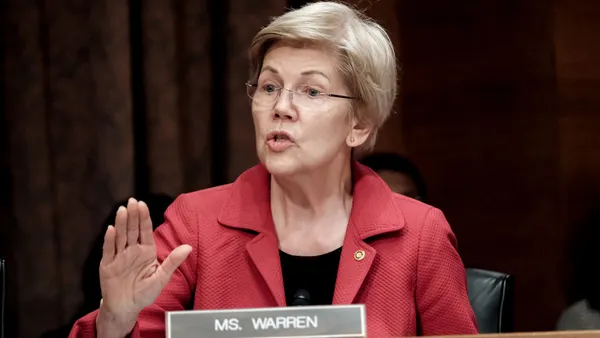Dive Brief:
- Bank of America and Goldman Sachs shareholders Wednesday rejected proposals to separate the banks’ board chair and CEO roles.
- Goldman voters, during the bank’s annual meeting, gave the proposal 33% support, based on a preliminary tally. That was up from 16% for a similar proposal last year, Reuters reported. About 31% of Bank of America voters supported the measure, according to preliminary results. Last year, a similar proposal received 26% of shareholder support, according to Reuters.
- Proxy advisers Glass Lewis and Institutional Shareholder Services both recommended shareholders vote in favor of the proposals to split the roles.
Dive Insight:
According to ISS, 58% of the biggest U.S. banks had combined CEO-chair roles as of last year, compared with 40% for all companies in the S&P 500, Reuters reported.
The idea to separate the two roles has gained steam in recent years amid broader efforts to enhance companies’ corporate governance. But Bank of America and Goldman have maintained that the lead independent directors they have appointed ensure robust oversight.
A Bank of America spokesperson declined to comment on Wednesday’s vote. In the bank’s proxy filing, the board’s recommendation that shareholders vote against the proposal noted that shareholders have had the opportunity to weigh in on the board’s leadership structure multiple times since 2015.
“There is no conclusive evidence demonstrating that an independent Chair ensures superior governance or performance, and Board flexibility to determine the optimal leadership structure continues to be the norm at other large companies,” Bank of America’s board said in the proxy filing.
In its proxy filing, Goldman’s board also recommended the company’s shareholders reject the proposal to split the CEO and chair roles, noting previous lack of support for such proposals and the sufficient level of independent leadership provided by the lead director. Goldman’s former CFO, David Viniar, replaced Adebayo Ogunlesi this month as independent lead director.
A representative for the proposal’s lead filer, the conservative National Legal and Policy Center, took Goldman CEO David Solomon to task Wednesday during the meeting.
“Over the last year, the need for Goldman Sachs to separate its CEO and chair positions has become obvious,” Luke Perlot, associate director of the Corporate Integrity Project at the NLPC, said in presenting the proposal. “Mr. Solomon's current dual role shields him from accountability for his numerous missteps.”
Among those: Solomon’s “poor decision-making” which led to “substantial losses” in the company’s retail banking division, including with the GreenSky unit it recently sold.
Overestimating Goldman’s ability to make headway in consumer banking illustrated “a lack of critical oversight that an independent Chairman might have mitigated,” Perlot said.
ISS noted much the same in its recommendation, asserting “Solomon’s foray into the consumer realm has been met with missteps and steep losses.”
Perlot also called out workplace culture challenges that have developed during Solomon’s tenure at the bank, such as high attrition rates among female leaders and gender discrimination allegations.
“Almost anyone can take the mic at a public shareholder meeting and say whatever they want,” a Goldman Sachs spokesperson said in an email. “We’re proud of our work to create an inclusive and supportive environment.”
JPMorgan Chase shareholders will vote, at that bank’s annual meeting next month, on a proposal seeking to strip CEO Jamie Dimon of his chairman role. The bank said in its most recent proxy filing that it plans to separate the roles “upon the next CEO transition.”
Separately on Wednesday, Glass Lewis failed to convince voters to reject Goldman Sachs’ pay plan. The package, which boosted Solomon’s compensation for 2023 by 24% to $31 million — despite a 24% decrease in net income at the bank on the year — received 86% support.
Kent Belasco, associate professor of finance at Marquette University, said he was surprised more of the banks’ shareholders didn’t support the measure to split the chair and CEO roles, pointing to Wells Fargo as a positive example. Former CEO John Stumpf held both titles during the period when employees at the bank opened millions of fake accounts, and Stumpf controlled what the board was made aware of, Belasco said.
“Better governance occurs if you split the roles,” Belasco said in an email. “If you have independence in the role, the chairman then has the ability to focus the board on harder issues and understand the realities.”
The issue has limited impact on credit ratings for big banks, though, said Mark Narron, senior director for North American banks at Fitch Ratings.
“While we generally look positively on greater board independence, in these specific instances we haven’t seen the executive chair structure as negatively affecting creditor interests,” Narron said in an email. “Ratings can be hurt by weak governance, but generally don’t move up for incremental adoption of best practices, particularly in the context of robust oversight structures and strong legal and regulatory environments.”












